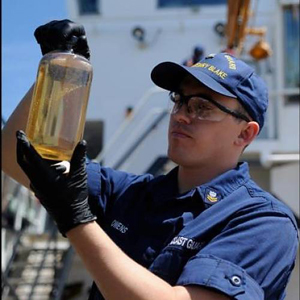U.S. Coast Guard Takes Algae Biofuel for a Spin
 The Navy’s biofuel program has been getting a lot of attention lately, along with biofuel initiatives by the Army and Air Force, and now it’s time for the U.S. Coast Guard to take a turn in the spotlight. The Coast Guard cutter Henry Blake has just taken its maiden voyage on a 50-50 blend of biofuel and conventional diesel, and if the results are satisfying, that will pave the way for using the blend on more ships in the future.
The Navy’s biofuel program has been getting a lot of attention lately, along with biofuel initiatives by the Army and Air Force, and now it’s time for the U.S. Coast Guard to take a turn in the spotlight. The Coast Guard cutter Henry Blake has just taken its maiden voyage on a 50-50 blend of biofuel and conventional diesel, and if the results are satisfying, that will pave the way for using the blend on more ships in the future.What is a cutter?
Those of you with a background in U.S. history (or a finger on the Google) know that “cutter” originally referred to “a small, decked ship with one mast and bowsprit, with a gaff mainsail on a boom, a square yard and topsail, and two jibs or a jib and a staysail.”
Nowadays the Coast Guard uses cutter to refer to any of its ships over 65 feet long. Aside from being relatively large, cutters are also the kind of ships that would give biofuel — or any new fuel — a good shakeout. Straight from the USCG FAQ page: “the cutters in the fleet have always been capable of handling a multitude of missions, sail in any weather, and persevere through any crisis the nation has had. Most have been long-lived as well.”
Biofuel for the Henry Blake
The Henry Blake is 175 feet long and has a crew of 28. It has a law enforcement function and it performs search-and-rescue missions, as well as performing various maintenance and environmental duties in the Puget Sound and San Juan Island area, including routine maintenance for about 200 navigation buoys.
The Henry Blake will be cruising around for several months on the 50-50 blend while performance and efficiency data are compiled.
Algae biofuel for the U.S. Coast Guard
Doug Esser reported on the new biofuel initiative for the Associated Press, and he has some interesting details to add.
The Henry Blake is an important test bed for algae biofuel (yes, the blend contains algae biofuel) because of the herky-jerky nature of its daily routine. It’s like a delivery truck, not a long distance hauler, so its engine undergoes a good deal of stress from revving up to get from one buoy to the next, with long periods of idle in between.
In addition, the Henry Blake is the first ship that will run all of its systems on the biofuel blend. Aside from the engine, that includes emergency equipment and backup pumps.
Great Green Fleet, Great White Fleet
Though the Henry Blake won’t make it into the upcoming Rim of the Pacific (RIMPAC) international maritime exercise, the U.S. Navy will be able to use its performance data to expand the list of sea-tested biofuel ships and aircraft.
The Navy is sending a Green Strike Group to RIMPAC, in preparation for the launch of the Great Green Fleet in 2016.
As with the strike group, all ships and aircraft in the Green Fleet will run with the help of non-petroleum fuels (that includes nuclear power, btw), serving as a global showcase for the future of naval power as envisioned by the U.S.A.
If the “Green Fleet” name rings a bell, that refers to President Theodore Roosevelt’s Great White Fleet, a flotilla of sixteen brand new battleships that went on a 43,000 mile cruise around the world from December 1907 to February 1909.
The Great White Fleet showed off America’s state-of-the-art shipbuilding and technological prowess to the world, and likewise the Great Green Fleet is intended to demonstrate this country’s leadership in new alternative energy technologies for future seapower.
With a mission like that, the Great Green Fleet should enjoy the full support of Congress — especially from the “support our troops” side of the aisle — but, on the other hand, maybe not.
You can return to the main Market News page, or press the Back button on your browser.

